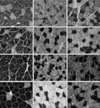This article has been corrected. See "Corrigendum" in Volume 41 on page 732.
Abstract
Purpose
The purpose of this study was to examine the effects of exercise on muscle weight and Type I and II fiber cross-sectional area of affected and unaffected hindlimb muscles in rats with neuropathic pain induced by unilateral peripheral nerve injury.
Methods
Neuropathic pain was induced by ligation and cutting of the left L5 spinal nerve. Adult male Sprague-Dawley rats were randomly assigned to one of two groups: The Pain+Exercise (PE) group (n=21) and the Sham+Exercise (SE) group (n=20). All rats had 28 sessions of treadmill exercise at grade 10 for 30 minutes, twice/day at 10 m/min for 14 days. Body weight, food intake and activity were measured every day. At 15 days all rats were anesthetized and soleus, plantaris and gastrocnemius muscles were dissected. Muscle weight and Type I, II fiber cross-sectional area of the dissected muscles were measured.
Figures and Tables
Figure 1
Cross-section of the hindlimb muscles in Pain+Exercise and Sham+Exercise rats. The first line is the affected soleus (left), plantaris (middle) and gastrocnemius muscle (right) in Pain+Exercise rats. The second line is the unaffected soleus (left), plantaris (middle) and gastrocnemius muscle (right) in Pain+Exercise rats. The third line is the affected soleus (left), plantaris (middle) and gastrocnemius muscle (right) in Sham+Exercise rats. The fourth line is the unaffected soleus (left), plantaris (middle) and gastrocnemius muscle (right) in Sham+Exercise rats. Dark=Type I muscle fiber, light=Type II muscle fiber (Myosin ATPase straining, 100×).

References
1. Blundell JE, King NA. Exercise, appetite control, and energy balance. Nutrition. 2000. 16:519–522.
2. Chapman V, Suzuki R, Dickenson AH. Electrophysiological characterization of spinal neuronal response properties in anesthetized rats after ligation of spinal nerves L5-L6. Journal of Physiology. 1998. 507(Pt 3):881–894.
3. Chiechio S, Copani A, Nicoletti F, Gereau RW. L-acetylcarnitine: A proposed therapeutic agent for painful peripheral neuropathies. Current Neuropharmacology. 2006. 4:233–237.
4. Choe MA, An GJ. Effects of exercise before steroid treatment on type I and type II hindlimb muscles in a rat model. Journal of Korean Academy of Nursing. 2007. 37:81–90.
5. Choe MA, An GJ. Effect of dehydroepiandrosterone on affected and unaffected hindlimb muscles in rats with neuropathic pain induced by unilateral peripheral nerve injury. Journal of Korean Academy of Nursing. 2009. 39:632–640.
6. Choe MA, An GJ, Lee YK, Im JH, Choi-Kwon S, Heitkemper M. Effect of inactivity and undernutrition after acute ischemic stroke in a rat hindlimb muscle model. Nursing Research. 2004. 53:283–292.
7. Choe MA, Kim KH, An GJ, Lee KS, Choi JA. Hindlimb muscle atrophy of rat induced by neuropathic pain. Journal of Korean Biological Nursing Science. 2008. 10:88–95.
8. Chung KY, Shin SW, Choi BS, Kim CH, Kim KH, Kim HK. Spinal α2 adrenoceptor and antiallodynic effect by clonidine after chronic administration of 4-methylcatechol in neuropathic rat pain model. The Korean Journal of Pain. 2008. 21:179–186.
9. Daemen MA, Kurvers HA, Bullens PH, Slaaf DW, Freling G, Kitslaar PJ, et al. Motor denervation induces altered muscle fibre type densities and atrophy in a rat model of neuropathic pain. Neuroscience Letters. 1998. 247:204–208.
10. Hutchinson KJ, Gomez-Pinilla F, Crowe MJ, Ying Z, Basso DM. Three exercise paradigms differentially improve sensory recovery after spinal cord contusion in rats. Brain. 2004. 127:1403–1414.
11. Kim JY. Effects of short-term undernutrition on type I and II muscles in rat. 2005. Seoul: Seoul National University;Unpublished master's thesis.
12. Kim SH, Chung JM. An experimental model for peripheral neuropathy produced by segmental spinal nerve ligation in the rat. Pain. 1992. 50:355–363.
13. Lee EO, Choe MA. Pain-theory and intervention. 1996. Seoul: Sinkwang.
14. Lee EO, Im NY, Park HA. Nursing/medical research and statistical analysis. 1998. 3rd ed. Seoul: Soomoonsa.
15. Leem JW, Gwak YS, Chung SS, Lee KR, Yoon DM, Nam DS. Effects of NO synthase inhibitor on responsiveness of dorsal horn neurons in neuropathic pain animal model. Journal of the Korean Pain Society. 2000. 13:19–30.
16. Lieu F, Power SK, Herb RA, Criswell D, Martin D, Wood C. Exercise and glucocorticoid-induced diaphragmatic myopathy. Journal of Applied Physiology. 1993. 75:763–771.
17. Luciano CA, Pardo CA, McArthur JC. Recent developments in the HIV neuropathies. Current Opinion in Neurology. 2003. 16:403–409.
18. Naganska E, Taraszewska A, Matyja E, Grieb P, Rafaowska J. Neuroprotective effect of erythropoietin in amyotrophic lateral sclerosis (ALS) model in vitro: Ultrastructural study. Folia Neuropathologica. 2010. 48:35–44.
19. O'Leary MF, Hood DA. Effect of prior chronic contractile activity on mitochondrial function and apoptotic protein expression in denervated muscle. Journal of Applied Physiology. 2008. 105:114–120.
20. Sakurai T, Takei M, Ogasawara J, Watanabe N, Sanpei M, Yoshida M, et al. Exercise training enhances tumor necrosis factor-α-induced expressions of anti-apoptotic genes without alterations in caspase-3 activity in rat epididymal adipocytes. Japanese Journal of Physiology. 2005. 55:181–189.
21. Sato J, Perl ER. Adrenergic excitation of cutaneous pain receptors induced by peripheral nerve injury. Science. 1991. 251:1608–1610.
22. Schmader KE. Epidemiology and impact on quality of life of postherpetic neuralgia and painful diabetic neuropathy. Clinical Journal of Pain. 2002. 18:350–354.
23. Trifiletti RR. Neuroprotective effects of NG-nitro-L-arginine in focal stroke in the 7-day old rat. European Journal of Pharmacology. 1992. 218:197–198.
24. Woolf CJ, Mannion RJ. Neuropathic pain: Aetiology, symptoms, mechanism, and management. Lancet. 1999. 353:1959–1964.
25. Ziegler D, Gries FA, Spuler M, Lessmann F. Diabetic cardiovascular autonomic neuropathy multicenter study group: The epidemiology of diabetic neuropathy. Journal of diabetes and its complications. 1992. 6:49–57.




 PDF
PDF ePub
ePub Citation
Citation Print
Print






 XML Download
XML Download